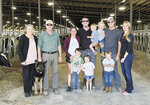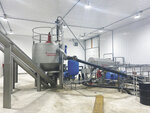



BERLIN, Wis. — Sand has been the bedding of choice at Trillium Hill Farm since 2014. Therefore, when the Jones family was looking to install a digester, sand was not something they were willing to give up. A separator new to the U.S. would provide the perfect means of sand separation for the Joneses — removing sand from manure while reclaiming nearly all of it for future use.
Today, the dairy reclaims 98% to 99% of its sand used for bedding and has gone from buying 14 dump load trucks of sand per week to buying only six loads per year.
“It’s a huge dollar savings,” Ben Jones said. “It also saves on wear and tear on the roads. By not hauling so much sand, we’re helping to save the road infrastructure for the community.”
Ben and his brother, Mike, farm with their parents, David and Julie, near Berlin. The Jones family milks 1,800 cows three times a day in a double-24 parallel parlor. Cows average 102 pounds of milk per day with a 100,000 somatic cell count. Longevity is important to the Joneses. The family credits sand bedding as a major source of their success.
A Stjernholm sand separator has given the Joneses the ability to reclaim the majority of sand used on their farm.
“It’s amazing,” Mike said. “Achieving 99% sand separation is unreal.”
Made in Denmark, Stjernholm guarantees 90% sand retention, but Mike and Ben have pushed the system to new levels.
“It’s an extremely efficient system, and we make tweaks to increase efficiency,” Ben said.
Sand-laden manure is run through a high-efficiency pump where sand is separated from the fiber and liquid in the manure. The sand is then washed and reclaimed for future use. The system rotates between four augers, pushing out clean sand into the adjacent collection room. Ben said the system cleans the manure before it enters the separator and has a macerator to prevent things like hoof blocks and ear tags from entering the system.
“This is great for any farm not wanting to accept the status quo,” Ben said. “We didn’t want to bed with manure solids when adding the digester. We like the luxury that sand provides the cows. Sand is a better-quality product that results in healthier, happier cows.”
The Joneses are reclaiming 52 tons of sand per day and are using the sand five days after it comes off the auger.
“Bacteria counts are very low, and the sand has no smell,” Mike said.
Once the sand is removed from the manure, the manure is processed through a 2.5-million-gallon digester, capturing methane to make renewable natural gas which is cleaned on-site and injected into an Alliant Energy pipeline that connects into Ripon, Wisconsin.
Three Petals RNG/Novilla RNG owns and runs the digester, which produces an equivalent in gasoline production upward of 600,000 gallons per year. The digester was built within 12 months of contract signing with Trillium Hill Farm.
Ben said Trillium Hill Farm is one of only three farms in the U.S. using the Stjernholm sand separating system and the only farm in the country using it with a digester.
The Joneses have been reclaiming sand since April and began sending gas to the pipeline in October.
“When you pump manure, there’s no sand in it,” Ben said. “There is truly no other system providing clean sand like this in the world.”
By utilizing technologies from other industries, Stjernholm invented a system capable of reclaiming unprecedented amounts of sand.
“The heart of the system is based on a system we’ve been running for 26 years in the wastewater industry,” said Thomas Christiansen, Chief Commercial Officer and managing partner of Stjernholm. “From the dairy point of view, we know what’s coming in — sand and manure. But the wastewater industry is more challenging because we don’t know what’s coming in. There is a very high demand for separation ability.”
The result is clean sand that looks like it came straight from the beach. To achieve this outcome, a certain type of sand must be used with the separator. Before installing the sand separator, the Joneses used virgin or generic, quarry-based sand.
Now, they use a silicone-based sand that is perfectly round with no abrasive edges to cause wear on pumps or cling to things. The Joneses prefer this sand, citing it as better for cow comfort and health.
“The sand is 150 microns,” Mike said. “It’s extremely fine, yet hard. Diamond is a 9 on the hardness scale, and this sand is a 7. It keeps its round particle size and is part of the reason we jumped off the cliff on all of this. Everything is the same particle size, which makes it easy to separate and reclaim.”
The sand separation process is a closed, interconnected system that takes place in an enclosed, heated building.
“Everything is clean and accessible,” Ben said. “We don’t have to deal with a bunch of manure splashing around. In some sand-separating buildings, there are more gases in the air, but the odor in here is minimal. It’s a very clean system.”
The Joneses like the system’s small footprint. The sand storage area is a compact 80 feet by 60 feet, while the equipment room measures 40 feet by 60 feet.
“We don’t have to store a lot of sand because we use it fresh, which helps with the footprint too,” Mike said.
The sand separator runs on 48 horsepower, and the entire sand separation room runs off less than 80 amps of power, making electrical costs minimal. There are few moving parts, and maintenance costs are low as well, Mike said.
About 30 minutes per day is spent tending to the system, which includes 10 minutes in the processing room and 20 minutes moving sand. This does not count sampling time. Five hand samples are taken per day to test the manure.
“We take samples at different points of manure coming in and out,” Mike said. “We weigh it on both sides. This is how we know we are reclaiming 99% of the sand.”
Comments
No comments on this item Please log in to comment by clicking here